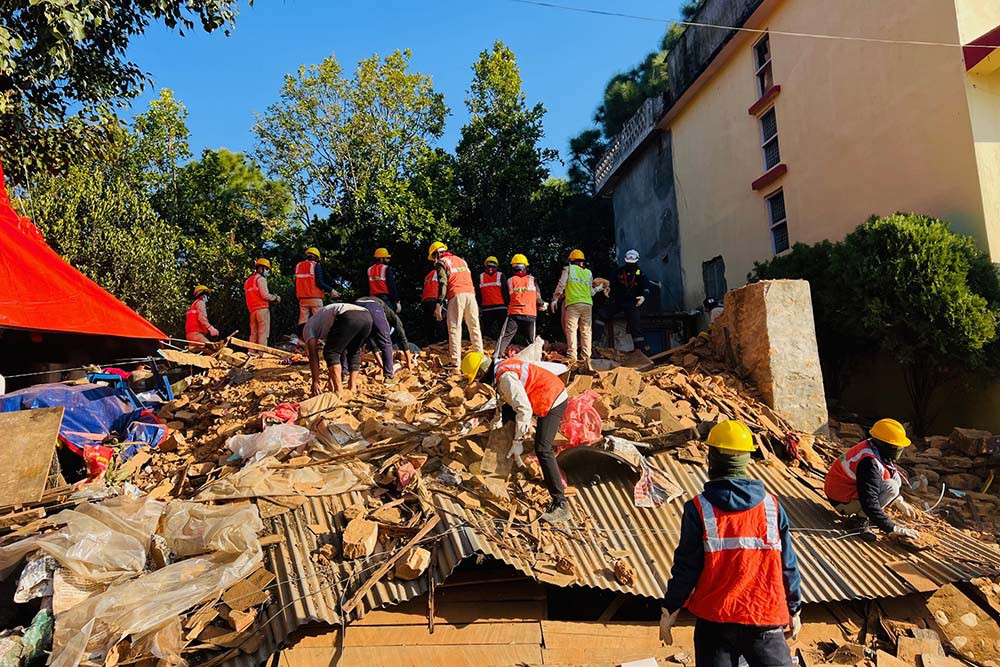
Though India and China, the two big neighbours of Nepal seem to be logged in the battlefield for expanding sphere of influence; specially in South Asia, the concept of trilateral cooperation between the three nations have been making quiet inroads in the past decade.
Off late, Nepal as a ‘yam between two boulders’ has been promoting the idea of bridging cooperation between India and China. The concept of trilateral cooperation seems to have gathered momentum after Chinese President Xi Jinping took office in 2013 and subsequently launched ‘Belt and Road Initiative (BRI)’, one of the most ambitious projects that envisions connecting Asia with Europe and Africa.
For China, which aims to dethrone the United States as the economic leader, it is important to enhance trade with India which is among the most populated countries in the world. India, on the other hand, requires supplies from China to sustain its economic growth rate that is growing by leaps and bounds. Nepal, on the other hand, seems to be looking at an opportunity to embark on a development journey bridging differences between the two nations.
Though the concept of trilateral cooperation has been making all the right noise, bilateral cooperation between the three nations still seems to be at the driving seat.
Win-Win Cooperation
While economic powers - India and China - seem to be increasing stakes on the global level, Nepal is actively seeking to establish itself as a developing country. Analysts say that Nepal as a neutral state can play a crucial role in bettering relationship of the two big nations. “Nepal has abundant natural resources. However, we lack funds as well as technical know-how to take off,” Tanka Prasad Karki, former Ambassador of Nepal to China said. “China has abundant capital as well as technology; whereas, India has market that is easily accessible from Nepal. We can do wonders by bringing them together.” The concept of Chinese investment and technology, Nepal as a manufacturing hub and India as market, according to experts, can also create an eco-system that can benefit not just the three nations but the entire South Asia. Nepal being the chair of South Asian Association for Regional Cooperation (SAARC) can also mediate not just India and China but the entire region towards creating a bigger market. According to Professor Li Tao, Executive Director, Institute of South Asian Studies, Sichuan University China is hopeful that the incumbent government led by KP Sharma Oli will strengthen infrastructure construction in Nepal and vigorously promote Nepal’s economic development, and strengthen cooperation between Nepal and China. “We are hopeful that Nepal can become an important transit in the development of BRI,” Li said indicating at the fact that enhancement of connectivity with Nepal for China is not just limited to its interest of bettering connectivity with Nepal but deepening engagement with India also.Issues & Challenges
Though Nepal-China-India trilateral cooperation seems to be win-win affair for all stakeholders, it’s a tough job to get it realised. The not-so-friendly relationship between China and India needs a lot of work. China and India have so far engaged in border disputes resulting into three military conflicts: the Sino-Indian War of 1962, the Chola incident in 1967, and the 1987 Sino-Indian skirmish. The two nations also had recent clash along the disputed Sino-Bhutanese border showing the complexity they share. There is a deep mistrust not just in G2G (government-to-government) level but also in the P2P (people-to-people) level. Likewise, difference over ideology seems to be another big issue. Democratic India and communist China carry distinctively separate political agendas as well as global allies. Likewise, the special relationship China shares with Pakistan has made things complex. “India has its concern about the way BRI has been heralded and carried forward by China where India has some fundamental problems with regard to China-Pakistan Economic Corridor,” Swaran Singh, Professor of Diplomacy and Disarmament at Jawaharlal Nehru University said. “The Nepal-China-India Cultural corridor is very likely to be presented by China as one more component of BRI which can make it a non-starter.” Experts stress that Nepal as a neutral nation cannot make significant strides until and unless China and India come to a point of realisation that there is no alternate to expansion of cooperation if they wish to continue their growth momentum. The total India-China bilateral trade amounted to $71.48 billion in the fiscal year 2016-17, up from $70.73 billion in the fiscal year 2015-16.“It is hence important for Nepal to continue promoting the idea of trilateral cooperation and establish a mechanism having officials from the three nations discuss ways to tone down the differences,” Karki said. The then Prime Minister Pushpa Kamal Dahal, on the sidelines of 2016 BRICS Summit, had expressed desire to become a ‘dynamic bridge’ in a meeting with President Xi and Indian Prime Minister Narendra Modi, where the two leaders had expressed optimism and commitment to working towards that direction. Things, however, do not seem to be moving on that front. According to Karki, the incumbent government which is expected to be a stable power in Nepal for coming years should keep pushing the agenda in the days ahead. Moreover, while Nepal with this trilateral initiative can formulate tourism-centric development model, there are also several issues that demand attention. While economy of mid-hill Nepal will get a significant boost, Nepal will have to be cautious that the two big economics do not use its land for enhancing their benefits at the cost of severe environmental degradation or the likes, experts say. The issue of maintaining national sovereignty too will be crucial.Chinese inroads; Indian paranoia
In spite of several complexities, the engagement of both India and China in Nepal has increased significantly in recent years. While India’s presence in Nepal was always there since decades, Chinese side too seems to have scaled up the ante in the recent past. Be it infrastructure projects or cultural exchanges, both nations seem to be leaving no stone unturned to strengthen their presence in Nepal. Significant increment in FDI pledge from China in recent years justifies the increasing interest of China in Nepal. The two countries also seem to be making every possible move to acquire major infrastructure projects in Nepal. One of the former energy secretaries, seeking anonymity, recalled an incident when China had gone the extra mile to acquire license to develop 750MW West Seti Hydropower Project just because India had acquired rights to build Upper Karnali Hydropower Project and Arun III having aggregated generation capacity of 1800MW. This underscores the ‘level of competition’ between the two nations. While China has gained significant spike in Nepal in the past decade, India seems to be more concerned towards recovering its lost ground, specially after the promulgation of the new constitution that triggered the southern neighbour to impose economic blockade over Nepal. Another aspect that has pressurised India is expansion of Chinese railway line to Nepal that is expected to touch Sino-Nepalese borders in Keyrung by 2022. According to Professor Li, Chinese scholars have made five suggestions regarding the China-Nepal Railway. They point out that the railway should be speeded up as a key project of the BRI. Second, since the main section of Nepal-China Railway is all within China, hence the section can be constructed timely. Thirdly, the Nepal-China Railway (especially the Nepalese part) may consider seeking help from the China Development Bank, the Silk Road Fund or the International Multilateral Development Bank including the World Bank, the Asian Development Bank and the Asian Infrastructure Investment Bank is also a potential financing target. Fourth, continue to maintain close contact with Nepal over the construction of the railway, enhance the institutionalised level of bilateral cooperation, and strive to establish a dialogue mechanism of normalisation at the vice premier level so as to provide a solid political guarantee for the construction of the railway. And finally, there needs to be efficient communication and reassurance with India in order to gain its understanding and support towards the construction of the railway. “If necessary, establish a trilateral cooperation committee of China-Nepal-India to study the feasibility of the China-Nepal Railway extending to India to quell India’s potential dissatisfaction,” Li said, stressing at the need of participation of India in the mega project.The brighter side
Though the concept of Nepal-China-India trilateral cooperation seems to be full of issues and challenges, there also are some positive aspects to look forward to. India, which has allied with Japan to counter BRI initiative by launching Asia-Africa Growth Corridor (AAGC) that envisions to better integrate economies of South, Southeast, and East Asia with Oceania and Africa is the second largest shareholder of China led Asian Infrastructure Investment Bank (AIIB), an institution that is considered as the backbone of BRI initiative. Similarly, the two nations are also members of BRICS nation which has changed the stereotype concept of regional integration and has been working towards expediting economic growth rate within the region and agreed to extend cooperation within the member states. Despite having apprehensions, India too seems eager to enhance connectivity with China for its own benefit. “Surely India believes in connectivity and has been part of several components of BRI. These include the two-decade old Kunming initiative (now BCIM Economic Corridor) and AIIB,” Singh says, adding that a cultural corridor initiated by taking into account of everyone’s’ concern can surely yield great potential for all three – Nepal, China, and India – in exploring possibilities of trilateral cooperation. Moreover, Karki feels the expenditure of India as well China would go significantly high if they were to establish defense mechanism right across the Himalayas. “And this is also a reason why Nepal can play an active role whose benefit will spread across India and China as they have a neutral nation which is able to address each others concern and create a win-win environment for all,” Karki says.”
Published Date: April 17, 2018, 12:00 am
Post Comment
E-Magazine
RELATED Feature





